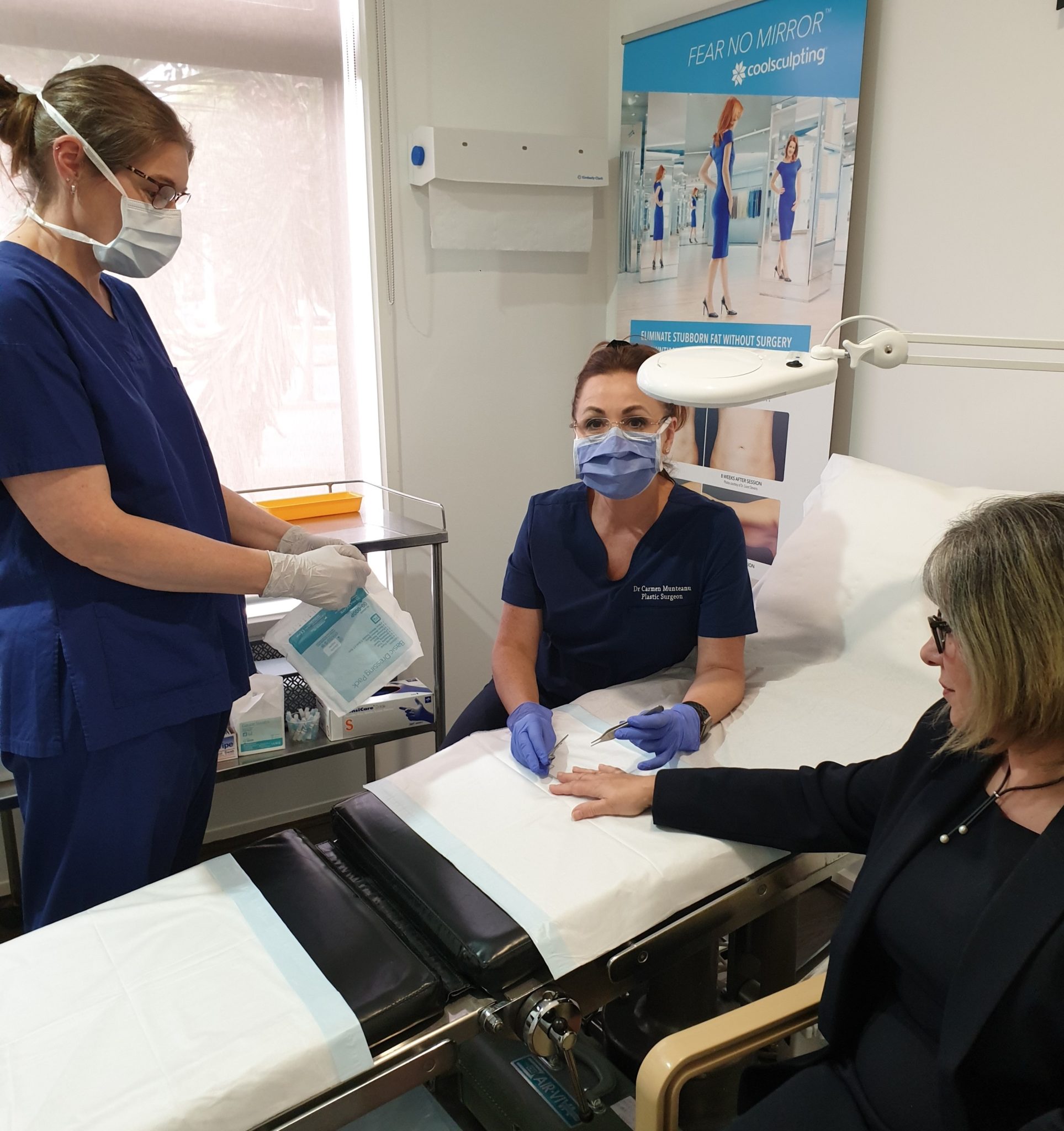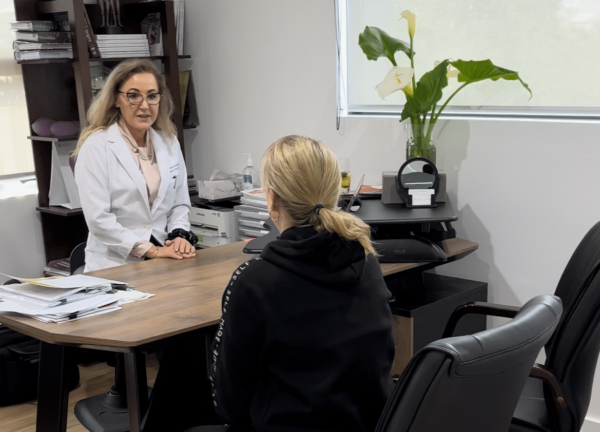What is Breast Reduction Surgery?
A breast reduction or boob reduction procedure focuses on reducing the size of the hypertrophic breast with appropriate skin redraping while maintaining a viable nipple-areola complex. For many women, breast reduction offers lasting conical projection, preserving areola sensation and minimal scarring.
Dr Carmen Munteanu, Melbourne Plastic Surgeon can combine a breast reduction procedure with body contouring techniques, including liposuction. In fact, if the breast size is found to be mostly due to fatty tissues and there is no issue with excess skin, it is possible that liposuction alone could be used to achieve the desired results.
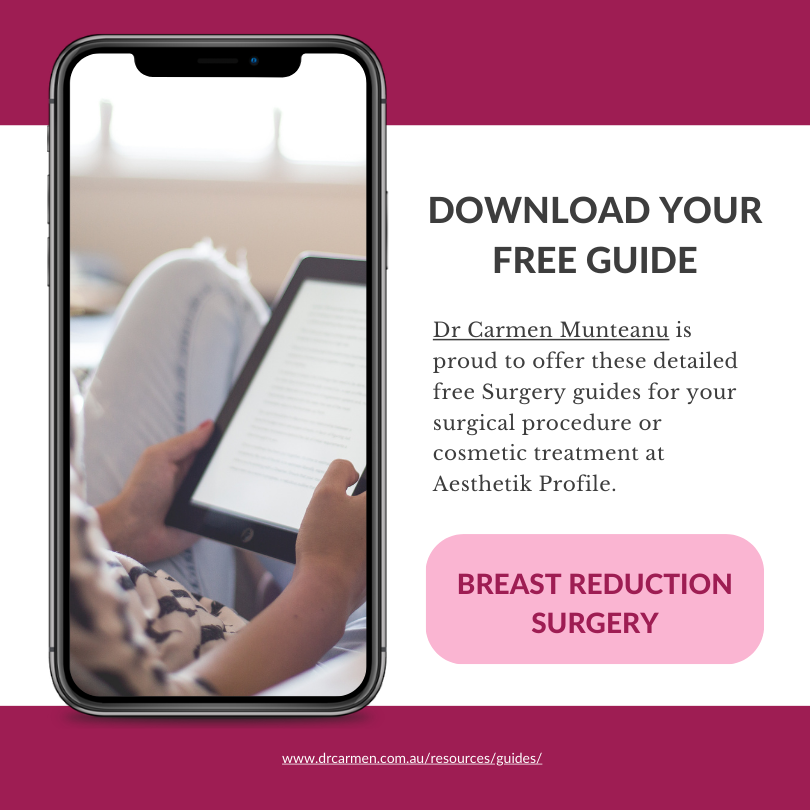
Download Dr Carmen’s Guide to
Breast Reduction Surgery
– Reduction Mammaplasty
Am I a good candidate for breast reduction surgery?
There are a number of symptoms and signs that might indicate you are the ideal candidate for breast reduction surgery that go beyond simply wanting smaller breasts. As this is a relatively significant elective form of cosmetic surgery, you will need to work with your plastic surgeon to determine whether or not you are a good candidate for breast reduction. Not only does having overly large breasts often present significant physical challenges, they can also create a substantial amount of emotional discomfort and stress.
Common signs you are suitable for breast reduction surgery
While you may simply think your breasts are too large and having smaller breasts might make you look and feel better, that is only a small portion of what is taken into consideration when discussing the possibility of breast reduction surgery. Here are several other very important signs that must be taken into consideration.
- Breasts seem to be out of proportion to the rest of your body.
- Pain in the neck, back, and shoulders caused by the weight of your breasts.
- Grooves in the tops of your shoulders that have been caused by your bra straps.
- The weight of your breasts is adversely affecting your posture.
- Disproportionate body shape to your clothing size.
- Your clothes may sag around your shoulders or gather at your abdomen? You may be forced to buy larger clothing sizes to accommodate your breast size?
- Breasts that droop due the excess weight causing your nipples and areolas to point downwards.
- Being unable to participate in sports or other physical activities due to the size/weight of your breasts.
- Having breasts that are unequal in size with one being significantly larger.
- Constant rashes and infections in the skin under your breasts.
- Having a hard time sleeping due to discomfort caused by overly large breasts.
- Frequent sore ears or stiff neck when waking.
- Feeling self-conscious about the size of your breasts in public.
Breast Reduction Before & After Photos of Real Patients
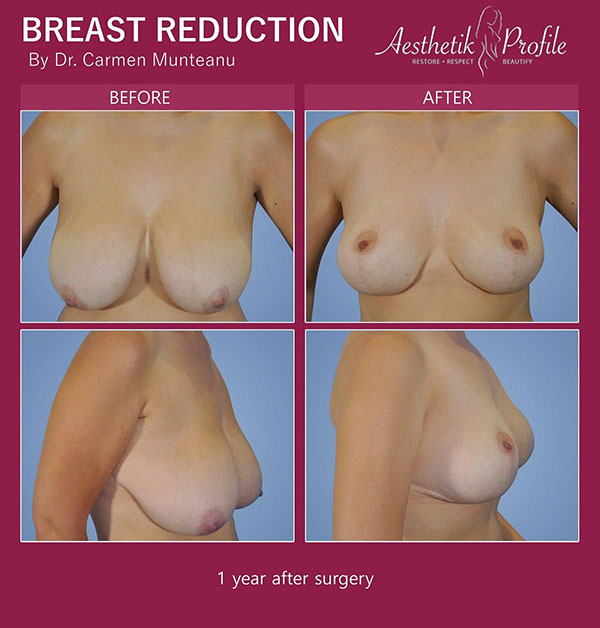
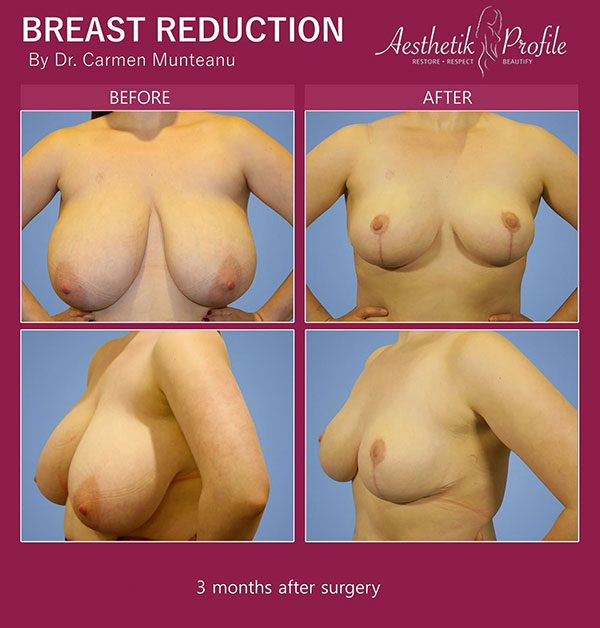
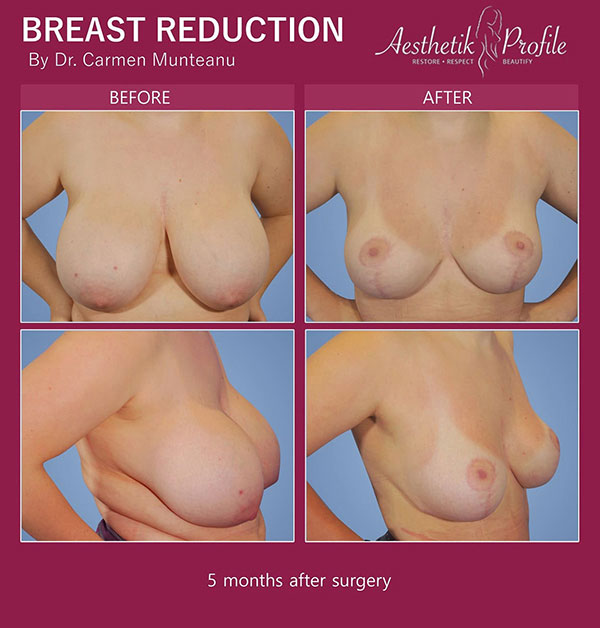
View the Breast Reduction Before & After Photo gallery of real patients of Dr Carmen.
Breast Reduction Surgical Procedure
The technique chosen for you will be carefully chosen based on your individual anatomy and unique needs.
1 – Anesthesia
To ensure your comfort during the breast reduction procedure, either intravenous sedation or general anesthesia will be administered. We will make a recommendation on the best choice for your unique circumstances.
2 – The incision
There are two options for the incision for your breast reduction surgery; a keyhole or racquet-shaped pattern, or an inverted T or anchor-shaped pattern. We discuss these further in the section below.
As mentioned above, liposuction can also be used to solve excess heaviness, but this procedure is limited to “fatty” breasts. Depending on your unique needs and circumstances, a combination of procedures may be required to give the best outcome.
3 – Removing tissue and repositioning
Once the incision has been made, the nipple is then repositioned. The nipple remains tethered to its original blood and nerve supply. If necessary, the areola diameter can be reduced by excising skin at the perimeter. In some extremely large-breasted women it may be necessary to remove the nipple and areola and reposition it to a higher location on the breast, but this is rare. This procedure is known as a free nipple graft.
Your underlying breast tissue will be reduced before the remainder of your breast tissue is then shaped and lifted.
4 – Closing the incisions
Once the breast tissue has been reduced, the incisions made in the skin are then brought together, reshaping the now smaller breast. In order to support the newly shaped breast, sutures are layer deep within the tissue. Sutures, skin adhesives or surgical tape will then be used to close the skin.
The lines left on your breasts by the incisions are permanent, but most women find that with time they fade and improve significantly. These scars can be easily concealed beneath a bra or swimsuit.
Recovery after Breast Reduction Surgery FAQs
The results of your breast reduction surgery will be visible immediately after the procedure. Post-surgical swelling will resolve with time, and incision lines, while permanent, will continue to fade.
Your final results will appear over the coming months as your new breast shape and position settle, and your satisfaction with your new image should grow as you continue to recover.
Longer-Term Results
While the results of your surgery will be long-lasting, it should be noted that your breasts can continue to change thanks to gravity and the natural aging process. Keeping a healthy lifestyle and maintaining your weight will help you to retain your new look for longer.
It must also be noted that while this procedure generally achieves good results, there is no guarantee. Certain patients may not be able to achieve optimal results in a single surgery, and a subsequent surgery may be required.
To achieve the best results possible, it’s essential you follow Dr Carmen’s post-operative instructions, and that the incisions are not subjected to any excessive motion, force, swelling or abrasion during the healing process. The instructions we provide will be personalised for your unique circumstances.
How much is a Breast Reduction in Melbourne? – prices & costs
All Surgery is customised and Dr Carmen’s team will give you a price for your surgery that will depend on the exact type of procedure you require, the hospital you attend and the length of your stay.
After your initial consultation, you will be given a detailed quote. This will include the Surgeon’s fee, Anaesthetist fee, Surgical Assistant fee and the hospital fees.
We can also provide information on Payment Plans, Finance, Private Health Insurance and different methods of payment.
Breast Reduction FAQs
Risks and Complications of Breast Reduction Surgery
Every surgery has some risks and possible complications.
Dr Carmen will cover the potential risks and complications during your consultation as part of your informed consent. She will also explain the measures she will take in order to reduce your risks as much as possible.
Possible complications of surgery include the following:
- Complications related to general anaesthetic or side effects of drugs used in hospital
- Bleeding – reduced by preoperative testing of possible blood anomalies, accurate technique, use of drains, particular dressings, compressive garments
- Infection – prevented/reduced by judicious use of antibiotics, good surgical technique, modern sealing dressings, appropriate care, advice
- Abnormal or asymmetrical scarring– Many scars can be improved if approached in the right time frame in the right way.
- Fluid build-up or seroma
- Other risks include – Numbness and Pain, Wound breakdown and delayed healing, unsightly or keloid Scarring,
- Serious complications such as possible Heart attack, Deep Vein Thrombosis, Pulmonary Embolism
For more information about risks of surgery and possible complications
Specific possible complications of breast surgery can include the following:
- Changes to nipple sensation majority transient in nature,
- Potential breast asymmetries– “breasts are sisters not twins”
- Risk of BIA-ALCL– Generally associated only with textured implants
- Risk of BII– Breast implant illness
Inflammation, Infection, Pain, Seroma, Scar presence, Asymmetry, Necrosis
Things you can do to minimise your risks and complications of surgery
- Read all your surgical documents and follow instructions of your surgeon precisely – rest & Allow time to heal, wear your compression garments as instructed, avoid removing your own bandages or touching at the incision site until it has healed properly.
- Do NOT Smoke at all during the surgical journey – especially critical in the periods before and after surgery
- Be accurate and upfront about ALL your medications, supplements and vitamins that you are currently taking – Tell both Dr Carmen and your anaesthetist
- When providing your medical history give specific details about ANY past difficulties you have had with surgery, anaesthesia, hospital visits or healing
- Thorough pre-washing of your own body prior to surgery can reduce skin bacteria and risk of infection.
- Successful surgical outcomes are the result of a number of considerations – realistic surgical goals, realistic patient expectations, and a good knowledge and understanding of possible risks and complications.
Further Reading – Useful Medical References
- American Board of Cosmetic Surgery Breast reduction Surgery Guide
- Clinics- Outcomes analysis of breast reduction in Brazilian women using the BREAST-Q® questionnaire: a cross-sectional controlled study
- WebMD page on breast Reduction Surgery
- American Society of Plastic Surgeon article on breast Reduction Surgery
- MayoClinic page on breast Reduction Surgery
Planning for your Breast Reduction surgery
During your consultation, Dr Carmen Munteanu will carefully listen to your reasons for surgery, discuss the procedure process and address the possible complications. Any history of breast cancer or lumps is of significance in this procedure and will be taking into consideration too.
Dr Carmen will examine your general state of health, your breast size, shape, and “footprint”, as well as the skin elasticity, and nipple and areola position. Based on this examination, she will determine the ideal surgery technique, as well as what can realistically be achieved.
You will then be presented with an individualised recommended treatment plan. This will include everything from the preparatory phase to your long-term care. Once you have made a well-informed decision on your surgery plan, Dr Carmen can confirm your surgery date.
You will be involved in all stages of the decision-making process, and Dr Carmen will address any issues based solely on your individual needs.
Dr Carmen places the highest priority on patient safety, and achieving superior results with minimal risk. The aesthetic appearance, scarring, reliability and long lasting results are all taken into consideration, but safety always takes priority.

